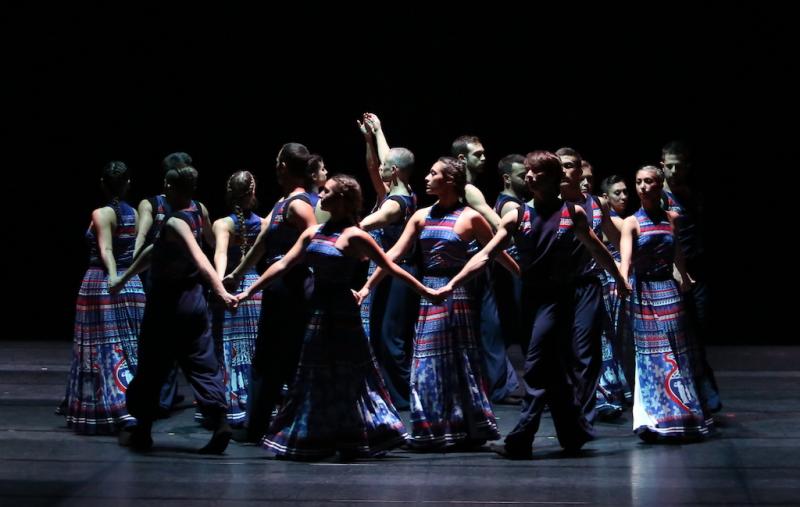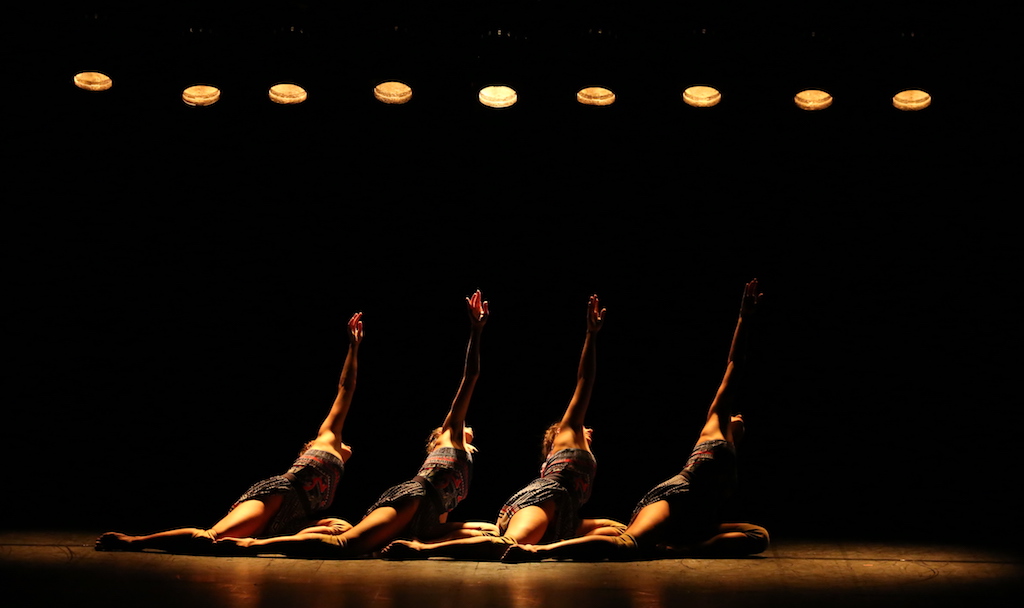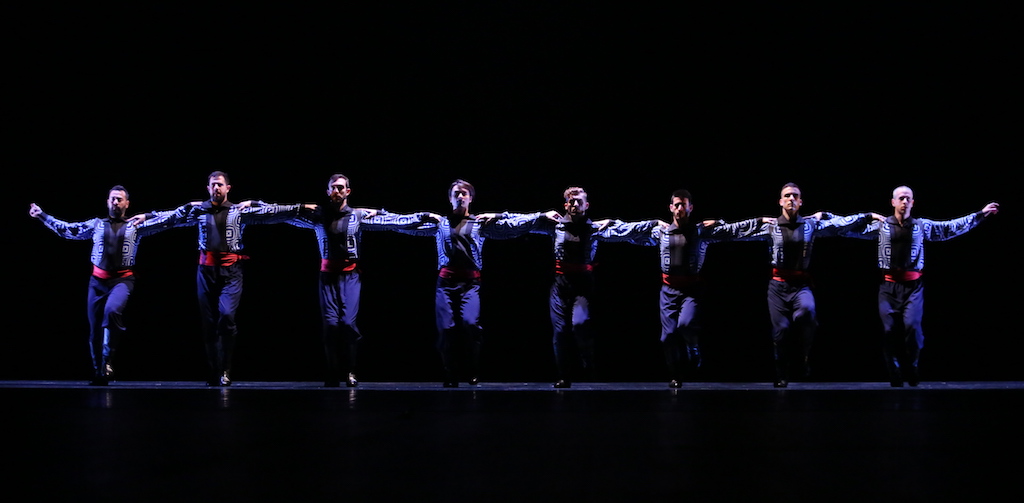The Thread, Russell Maliphant & Vangelis, Sadler’s Wells review – an inspiring marriage of old and new | reviews, news & interviews
The Thread, Russell Maliphant & Vangelis, Sadler’s Wells review – an inspiring marriage of old and new
The Thread, Russell Maliphant & Vangelis, Sadler’s Wells review – an inspiring marriage of old and new
Divergent worlds made to co-exist with apparent ease

In The Thread Russell Maliphant attempts what, at first sight, appears a foolhardy project – the juxtaposition of contemporary and traditional Greek dance. The two genres seem poles apart, the one being collective and in unison, the other more individualistic and expressive.
The piece is episodic, unfolding as a series of vignettes in which folk dances alternate with contemporary sequences. The result is mesmerising. Gliding serenely round the stage in long lines with linked arms, the dancers are reminiscent of the hieratic figures decorating ancient Greek vases. With their tight-fitting bodices and long pleated skirts, the women’s dresses (by Greek-born fashion designer Mary Katrantzou) echo the clothes depicted on the pots, so it seems as if the archaic figures have come to life. As the dancers circle and spiral in pools of golden light (by Maliphant’s long term collaborator Michael Hulls), they weave an enduring sense of continuity and community (main picture).
There’s a glorious moment when dancers flicking white handkerchieves drift across the stage in wave after wave. And there’s a Busby Berkeley moment when four women sit in a tight line and, like a single organism, extend their limbs in graceful unison (pictured below).
 With the main emphasis on fancy footwork and an upright stance, the folkdances could not be further removed from the liquid dynamism of Maliphant’s choreography, which features windmilling arms and low-flying spins, slides, tumbles and rolls. The marvel is the apparent ease with which these divergent worlds are made to co-exist. They are, though, not as far apart as they appear, since Maliphant’s athletic moves are inspired by another folk tradition – Ukrainian squat dances (think Cossacks in shiny boots). And by slowing the contemporary dancers down and having them perform in unison, he confers on their movements a solemnity that feels almost archaic. This, I thought, is how the ancient Greeks would have performed contemporary dance had it been around in 400 BC.
With the main emphasis on fancy footwork and an upright stance, the folkdances could not be further removed from the liquid dynamism of Maliphant’s choreography, which features windmilling arms and low-flying spins, slides, tumbles and rolls. The marvel is the apparent ease with which these divergent worlds are made to co-exist. They are, though, not as far apart as they appear, since Maliphant’s athletic moves are inspired by another folk tradition – Ukrainian squat dances (think Cossacks in shiny boots). And by slowing the contemporary dancers down and having them perform in unison, he confers on their movements a solemnity that feels almost archaic. This, I thought, is how the ancient Greeks would have performed contemporary dance had it been around in 400 BC.
The piece makes huge demands on the 18 dancers, though, since they have to be up to speed in both techniques. And while all are Greek, only six trained in the folk tradition, the others having studied ballet or contemporary. They had 18 months to master the complicated steps of the ensemble dances and Maliphant’s high-energy acrobatics, but their dedication has paid off. Not only are they able to switch seemlessly between genres, but the men elicited cheers from the audience as they whooped and stomped through a macho line dance (pictured below).
Natural sounds like these were mostly drowned out, though, by the thunderous soundtrack. Vangelis (of Chariots of Fire and Blade Runner fame) overlays insistent drumming with traditional stringed instruments and the reedy vibrations of ancient flutes, to darkly portentous effect. At one point, the men don cow bells which jangle menacingly as they surround a cluster of women. The scale is epic – more suited to a Hollywood blockbuster with a cast of thousands than 18 dancers on a modest stage – and the tension builds only to dissipate. It comes as a blessed relief when silence reigns long enough to appreciate the finger clicks and foot taps of a solo dancer traversing the space.
 The challenge of combining traditional and contemporary dance forms came from Greek impresario Georgia Illiopoulou; Maliphant decided to accept because he believes there are strong links between them, and the title of the piece reflects this conviction: “The Thread is the thing that carries us between the past, the present and the future,” he says. “Without traditional dance, would you have had classical dance? And without classical dance would you have had contemporary dance, hip hop and so on?”
The challenge of combining traditional and contemporary dance forms came from Greek impresario Georgia Illiopoulou; Maliphant decided to accept because he believes there are strong links between them, and the title of the piece reflects this conviction: “The Thread is the thing that carries us between the past, the present and the future,” he says. “Without traditional dance, would you have had classical dance? And without classical dance would you have had contemporary dance, hip hop and so on?”
In The Thread, Maliphant not only proves his point, but offers something more. Thinking about why I found the piece so consoling, it occurred to me that in these chaotic times we desperately miss having a sense of order and continuity. The Thread is like a healing balm, a vehicle through which Maliphant was able to respond to the zeitgeist with uncanny perspicacity.
rating
Explore topics
Share this article
The future of Arts Journalism
You can stop theartsdesk.com closing!
We urgently need financing to survive. Our fundraising drive has thus far raised £33,000 but we need to reach £100,000 or we will be forced to close. Please contribute here: https://gofund.me/c3f6033d
And if you can forward this information to anyone who might assist, we’d be grateful.

Subscribe to theartsdesk.com
Thank you for continuing to read our work on theartsdesk.com. For unlimited access to every article in its entirety, including our archive of more than 15,000 pieces, we're asking for £5 per month or £40 per year. We feel it's a very good deal, and hope you do too.
To take a subscription now simply click here.
And if you're looking for that extra gift for a friend or family member, why not treat them to a theartsdesk.com gift subscription?
more Dance
 Help to give theartsdesk a future!
Support our GoFundMe appeal
Help to give theartsdesk a future!
Support our GoFundMe appeal
 The Forsythe Programme, English National Ballet review - brains, beauty and bravura
Once again the veteran choreographer and maverick William Forsythe raises ENB's game
The Forsythe Programme, English National Ballet review - brains, beauty and bravura
Once again the veteran choreographer and maverick William Forsythe raises ENB's game
 Sad Book, Hackney Empire review - What we feel, what we show, and the many ways we deal with sadness
A book about navigating grief feeds into unusual and compelling dance theatre
Sad Book, Hackney Empire review - What we feel, what we show, and the many ways we deal with sadness
A book about navigating grief feeds into unusual and compelling dance theatre
 Balanchine: Three Signature Works, Royal Ballet review - exuberant, joyful, exhilarating
A triumphant triple bill
Balanchine: Three Signature Works, Royal Ballet review - exuberant, joyful, exhilarating
A triumphant triple bill
 Romeo and Juliet, Royal Ballet review - Shakespeare without the words, with music to die for
Kenneth MacMillan's first and best-loved masterpiece turns 60
Romeo and Juliet, Royal Ballet review - Shakespeare without the words, with music to die for
Kenneth MacMillan's first and best-loved masterpiece turns 60
 Vollmond, Tanztheater Wuppertal Pina Bausch + Terrain Boris Charmatz, Sadler's Wells review - clunkily-named company shows its lighter side
A new generation of dancers brings zest, humour and playfulness to late Bausch
Vollmond, Tanztheater Wuppertal Pina Bausch + Terrain Boris Charmatz, Sadler's Wells review - clunkily-named company shows its lighter side
A new generation of dancers brings zest, humour and playfulness to late Bausch
 Phaedra + Minotaur, Royal Ballet and Opera, Linbury Theatre review - a double dose of Greek myth
Opera and dance companies share a theme in this terse but affecting double bill
Phaedra + Minotaur, Royal Ballet and Opera, Linbury Theatre review - a double dose of Greek myth
Opera and dance companies share a theme in this terse but affecting double bill
 Onegin, Royal Ballet review - a poignant lesson about the perils of youth
John Cranko was the greatest choreographer British ballet never had. His masterpiece is now 60 years old
Onegin, Royal Ballet review - a poignant lesson about the perils of youth
John Cranko was the greatest choreographer British ballet never had. His masterpiece is now 60 years old
 Northern Ballet: Three Short Ballets, Linbury Theatre review - thrilling dancing in a mix of styles
The Leeds-based company act as impressively as they dance
Northern Ballet: Three Short Ballets, Linbury Theatre review - thrilling dancing in a mix of styles
The Leeds-based company act as impressively as they dance
 Best of 2024: Dance
It was a year for visiting past glories, but not for new ones
Best of 2024: Dance
It was a year for visiting past glories, but not for new ones
 Nutcracker, English National Ballet, Coliseum review - Tchaikovsky and his sweet tooth rule supreme
New production's music, sweets, and hordes of exuberant children make this a hot ticket
Nutcracker, English National Ballet, Coliseum review - Tchaikovsky and his sweet tooth rule supreme
New production's music, sweets, and hordes of exuberant children make this a hot ticket

Add comment